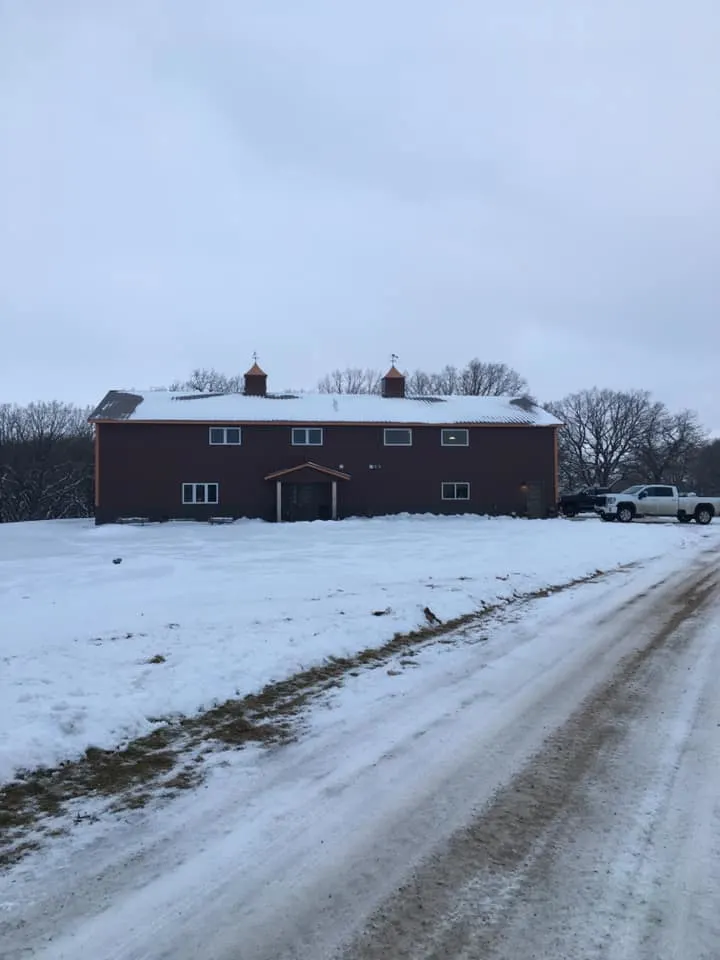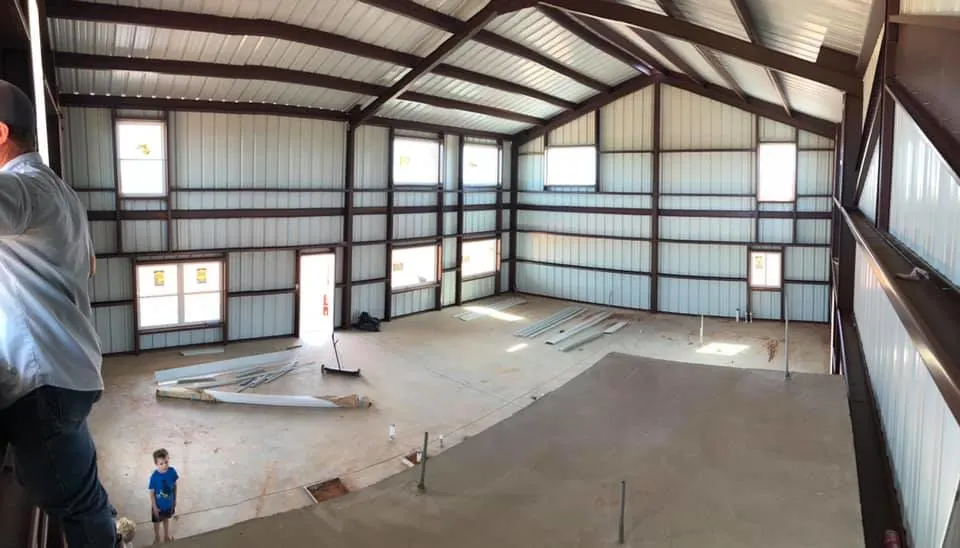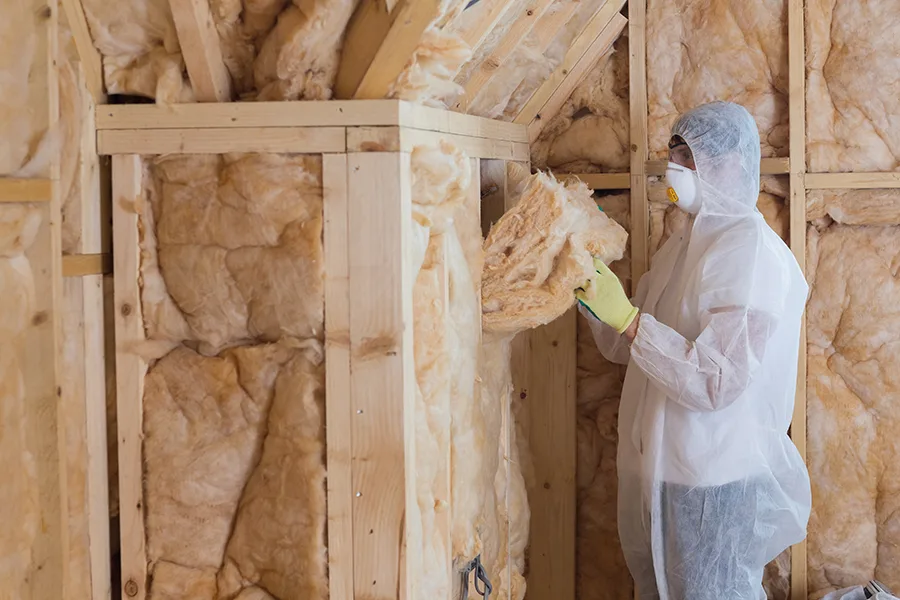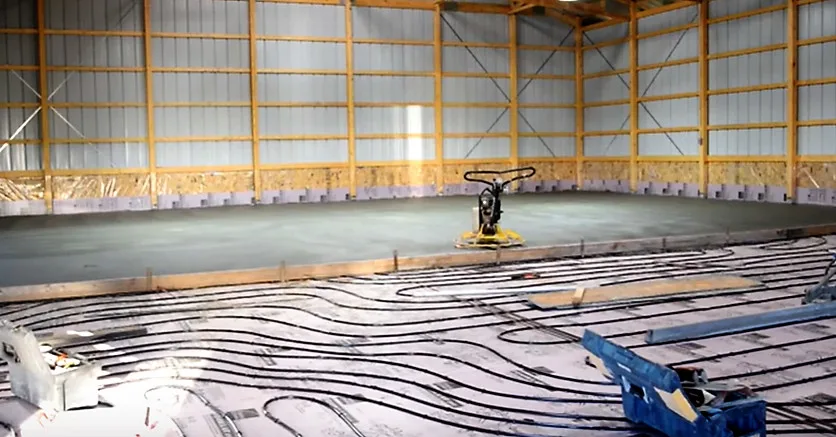Barndominiums have caught on across North America, especially in the southern US. Yet, before starting construction, you may wonder- can you build a barndominium in a cold climate? The design features offer many advantages, including increased stability and protection, but also require special considerations.
A barndominium constructed in a cold region should include adequate insulation and efficient heating systems. Taking advantage of natural light and certain building materials can also help keep a barndominium warmer. With the right choices, a cold climate is an ideal location for a barndominium. Here is a closer look.

Page Contents
Advantages of a Barndominium in Cold Regions
Barndominiums are often made with large frames and open floor plans. Instead of the wood stud frame found in most homes, barndos use pole framing or post-frame construction. New barndominiums are also typically made with steel frames instead of wood.
Steel frames provide several benefits over traditional wood frames in cold weather:
- Increased thermal conductivity
- Increased snow loads
- Less shifting and settling between seasons
Steel provides increased thermal conductivity compared to wood. Instead of retaining heat, the steel frame passes the warmth inside the home. The right design can help capture more sunlight and transfer the heat through your barndominium.
A solid steel frame can also support increased snow loads. The weight of snow increases the risk of roof problems in a standard home. You are more likely to experience roof damage, leaks, and other issues when living in a region that receives lots of snowfall. These issues are less of a risk with a barndominium.
Steel barndominiums are also less likely to shift or settle compared to wood-frame homes. Wood holds more moisture, which allows it to expand in warm weather and shrink in cold weather. The expansion and contraction of wood often cause the frame to shift and settle.
Shifting and settling may lead to cracks in the drywall and other minor cosmetic issues. However, over time, settling may promote foundation issues and other problems. These issues are less of a threat when living in a barndominium.

While barndominiums offer advantages in cold regions, you also need to pay attention to the following:
- Sunlight
- Exterior materials
- Insulation
- Floor plan
- Airflow
- Air leaks
To answer the question,’ Can you build a barndominium in a cold climate?’ use the following tips to ensure that your barndominium is prepared for colder weather.
Build Your Barndominium in an Area with Lots of Sunlight
While wood is a better insulator, metal is a better conductor of heat. High thermal conductivity allows steel buildings to absorb more energy from the sun’s UV rays.
You can heat the inside of your barndominium more efficiently if you position it in an area with lots of sunshine. The sun shines throughout the year. You may even receive more sunlight during the winter, as it reflects off the snow.
Using certain building materials can also help heat your barndominium in the winter. Siding and roofing made with copper or aluminum can transfer more heat to the inside of your barndominium.
Choose the Right Insulation for Your Barndominium
A metal frame is not a good insulator, requiring you to pay careful attention to the insulation for your barndominium. While metal siding and roofing can help heat your barndominium quickly, you need insulation to keep the warm air inside.
If you build a barndominium with a wood frame, you should still consider using extra insulation. Filling the wall cavities with high-quality insulation helps protect the wood posts from moisture. You may even use multiple insulation options, such as radiant barrier insulation and spray foam insulation.
Radiant barrier insulation is highly reflective. It helps redirect more heat into your barndominium, making it easier to maintain a warmer temperature.
Spray foam is often used inside the wall cavities, as it covers more of the interior. Compared to other forms of insulation, spray foam is also less likely to collect moisture. The foam is sprayed into the walls and expands, allowing it to fill every crack and crevasse.

Use an Open Floor Plan for More Efficient Heating
Dividing a rectangular building into hallways and multiple rooms makes it more difficult to heat and cool efficiently. It is easier to maintain temperatures in a large, open space. Luckily, barndominiums allow you to use open floor plans.
An open floor plan is a type of design where one or more living areas are combined to create a larger space. For example, the kitchen, dining area, living room, and entrance may blend instead of being separated by walls and doorways. The open design allows air to travel freely without obstruction. Fewer obstructions increase the efficiency of your heating system.
Install Ceiling Fans to Direct Warm Air Back to the Floor
Many barndominiums are built with tall, vaulted ceilings. Some designs may also include a loft or a mezzanine area. These design options look great but also limit the heating efficiency of your living space.
As warm air rises, it is replaced with cool air from outside. If you choose a barndominium design with tall ceilings, install ceiling fans to direct the warm air back to the floor. The fans should be set to spin clockwise. Setting the fan to spin clockwise at a low speed pulls cool air upward. The updraft then pushes the warm air down along the walls.
Seal the Exterior of the Barndominium to Prevent Air Leaks
A steel frame and adequate insulation should help keep your barndominium warm. However, air can still escape through the cracks. Even a small air leak can severely limit the heating efficiency of your barndominium. If you sit in a room with a draft, you are likely to notice a temperature difference.
Make sure that you seal windows and door frames. You should also properly seal the eaves, corners, and base panels to keep air from leaking. Apply caulk to any areas where air can travel between the inside and outside.
Consider Installing Radiant Heat Flooring
Installing radiant heat flooring is another cost-effective heating option for barndominiums. Radiant heat flooring relies on radiant heat transfer to warm your living spaces. Instead of sending warm air through ducts, the radiant heat system heats the flooring. The warm flooring then directly warms the walls, furniture, rugs, and occupants.
Radiant flooring can also be installed in a slab foundation, eliminating the need for a crawl space to support the ductwork for a standard furnace. Radiant flooring is also a recommended choice for homes with tall ceilings, which are common in barndominiums. Less heat travels to the ceiling, keeping the lower portions of your home warmer.
Installing radiant flooring often comes with higher up-front costs compared to traditional furnaces. However, the heating is more cost-efficient and should pay for itself after several years.

Conclusion: Can You Build a Barndominium In a Cold Climate?
Barndominiums offer increased thermal conductivity, which helps your home absorb more heat from the sun. You can also avoid drywall cracks and other risks associated with settling and shifting.
Yet, you also need to winterize your barndominium. Make sure that you use adequate insulation. Spray foam can provide superior coverage and higher insulating values. You may also want to install radiant flooring and ensure that your home is positioned in an area that receives lots of sunlight.
The bottom line is that barndominiums are more than suitable for cold climates. A barndominium is likely to provide more energy-efficient housing compared to traditional homes.
If you would like more guides like this one, check out the rest of BarndominiumLife.com. There, you will find more helpful tips and tricks from the pros. You will also find featured barndominiums, barndominium floor plans, and information on financing and insurance. Knowing as much as you can will help you get the best results for your dream home.
Gail currently spends her free time geeking out about what’s new and trending in the world of barndominiums.
She is the former executive editor of BarndominiumLife.com and loves working with the team and members of the barndominium community. She now contributes to the blog on occasion, but only when she feels like it!
